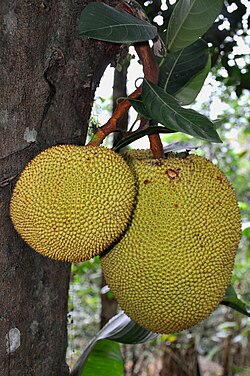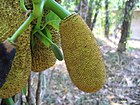Note: This is a project under development. The articles on this wiki are just being initiated and broadly incomplete. You can Help creating new pages.
Artocarpus heterophyllus - Panasa, Jackfruit
Panasa is a very important multipurpose tree. It is particularly valued for its fruit. The tree is widely cultivated in tropical regions, especially southeast Asia and Brazil.
Contents
- 1 Uses
- 2 Parts Used
- 3 Chemical Composition
- 4 Common names
- 5 Properties
- 6 Habit
- 7 Identification
- 8 List of Ayurvedic medicine in which the herb is used
- 9 Where to get the saplings
- 10 Mode of Propagation
- 11 How to plant/cultivate
- 12 Commonly seen growing in areas
- 13 Photo Gallery
- 14 References
- 15 External Links
Uses
Wound healing, Inflammation, Skin diseases, Ulcers, Bleeding[1]
Parts Used
Bark, Leaf, Heartwood, Seeds, Root, Stem[2]
Chemical Composition
Artocarpus heterophyllus contains the present review reveals that Artocarpus heterophyllus is a Chemically and Pharmacologically studied tree having diverse secondary metabolites present in its fruits and seeds such as Phenolics, Flavonoids, Terpenoids, Steroids, Glycosides, Saponins, Alkaloids and Tannins. Thus Jackfruit is considered to be a functionally, Nutritionally and Medicinally important fruit in all respects[3]
Common names
| Language | Common name |
|---|---|
| Kannada | Halasina hannu |
| Hindi | Kathal |
| Malayalam | Plavu, Chakka |
| Tamil | Palamaram |
| Telugu | Panasa |
| Marathi | NA |
| Gujarathi | NA |
| Punjabi | NA |
| Kashmiri | NA |
| Sanskrit | Apuspaphala, Kantakiphala, Panasa |
| English | Jackfruit |
Properties
Reference: Dravya - Substance, Rasa - Taste, Guna - Qualities, Veerya - Potency, Vipaka - Post-digesion effect, Karma - Pharmacological activity, Prabhava - Therepeutics.
Dravya
Rasa
Madhura (Sweet), Kashaya (Astringent)
Guna
Guru (Heavy), Snigdha (Slimy)
Veerya
Sheeta (cold)
Vipaka
Madhura (Sweet)
Karma
Pitta, Vata
Prabhava
Habit
Identification
Leaf
| Kind | Shape | Feature |
|---|---|---|
| Simple | Alternate | 8-23 x 3-13 cm, obovate, obovate-oblong, or elliptic-ovate, apex acute or obtuse, base acute, round or cuneate, margin entire, glabrous and shining above and scabrous beneath. |
Flower
| Type | Size | Color and composition | Stamen | More information |
|---|---|---|---|---|
| Unisexual | Spikes | Greenish yellow | 1 | Male from young branches, catkin narrow-cylindric; perianth 2-lobed, puberulous; stamen 1. Flowering from February to June |
Fruit
| Type | Size | Mass | Appearance | Seeds | More information |
|---|---|---|---|---|---|
| Sorosis | 30-45 x 20-25 cm | Oblong, tuberculate, tubercles conical yellowish-green, fruiting perianth yellow to light orange, fleshy | Seeds 10-12 x 8-10 mm, elliptic-oblong, smooth, glossy | Fruiting from February to June |
Other features
List of Ayurvedic medicine in which the herb is used
Where to get the saplings
Mode of Propagation
How to plant/cultivate
Under suitable conditions, germination begins within 10 days, and 80-100% germination is achieved within 35-40 days after sowing.[6]
Commonly seen growing in areas
Tropical area, Sub tropical area
Photo Gallery
References
- ↑ Uses
- ↑ ”Karnataka Medicinal Plants Volume-3” by Dr.M. R. Gurudeva, Page No.1253, Published by Divyachandra Prakashana, #6/7, Kaalika Soudha, Balepete cross, Bengaluru
- ↑ Journal of Pharmaceutical Sciences - Phytochemical profiling and antioxidant activities of different parts of Artocarpus heterophyllus - A review on current status of knowledge
- ↑ Vernacular names
- ↑ Botonic description
- ↑ Cultivation details
External Links
- Ayurvedic Herbs known to be helpful to treat Wound healing
- Ayurvedic Herbs known to be helpful to treat Inflammation
- Ayurvedic Herbs known to be helpful to treat Skin diseases
- Ayurvedic Herbs known to be helpful to treat Ulcers
- Ayurvedic Herbs known to be helpful to treat Bleeding
- Herbs with Bark used in medicine
- Herbs with Leaf used in medicine
- Herbs with Heartwood used in medicine
- Herbs with Seeds used in medicine
- Herbs with Root used in medicine
- Herbs with Stem used in medicine
- Herbs with common name in Kannada
- Herbs with common name in Hindi
- Herbs with common name in Malayalam
- Herbs with common name in Tamil
- Herbs with common name in Telugu
- Herbs with common name in Sanskrit
- Herbs with common name in English
- Habit - Tree
- Index of Plants which can be propagated by Seeds
- Index of Plants which can be propagated by Cuttings
- Herbs that are commonly seen in the region of Tropical area
- Herbs that are commonly seen in the region of Sub tropical area
- Herbs
- Moraceae





